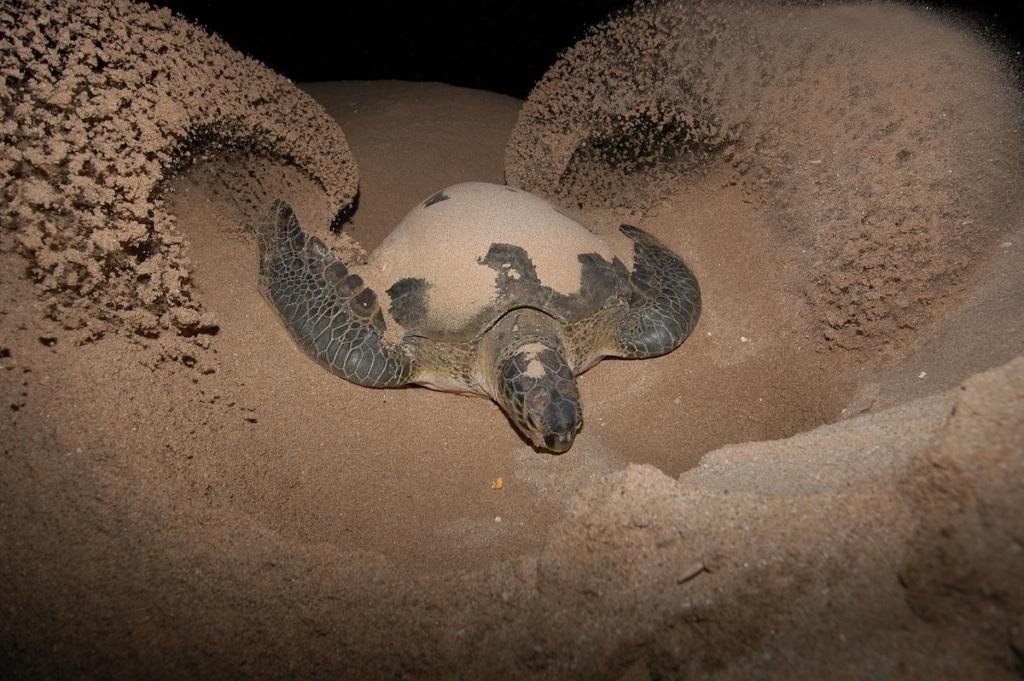Shells everywhere. Long considered “endangered,” the green turtle (Chelonia mydas) has been reclassified as “least concern” on the updated IUCN Red List of Threatened Species released this Friday. This success reflects decades of conservation efforts across tropical regions to protect these remarkable animals.
Every year, the same ritual unfolds on the shores of southern Africa, Indonesia, or the Caribbean. After swimming thousands of kilometers, female green turtles return to their natal beaches, slowly climb onto the sand, dig a hole, and lay around a hundred eggs. They repeat this process several times over weeks before returning to the open sea for several years.
The hatchlings emerging about 60 days later face immediate threats from crabs, birds, stray dogs, and other predators. Fewer than 1% survive to adulthood. Survivors then confront numerous other hazards that pushed the species toward extinction during the 20th century: hunting, bycatch, ship collisions, plastic pollution, and more.
Yet the seemingly tragic story of the green turtle is not doomed. After decades of protection, the species is no longer classified as “endangered” on the global Red List. Remarkably, Chelonia mydas has jumped from “endangered” (2004) to “least concern.”
“Some Species Show Us the Way Forward”
“The global green turtle population has increased by around 28% since the 1970s, despite ongoing threats to some subpopulations,” notes the IUCN. This positive trend stands in stark contrast to the rest of the Red List, where six new species were declared extinct and others, like Arctic seals and several tropical birds, have seen declining conservation status.
“While the situation continues to darken for many species, some show us that nothing is lost,” says Florian Kirchner, Species Program Officer at the French IUCN Committee. “They are our beacon of hope.” Earlier this year, a scientific study already highlighted improvements in most of the world’s seven marine turtle species—except the leatherback turtle, which faces rising threats.
Green turtles inhabit tropical waters across the Pacific, Atlantic, and Indian Oceans and are occasionally observed in French waters north of their normal range. A long-distance migrator, they travel thousands of kilometers between feeding grounds and nesting beaches.
In French Polynesia, increasing numbers of green turtles cross parts of the Pacific each year to reproduce on Tetiaroa Atoll. “On nesting sites, tracks went from about twenty in 2006 to 1,400 in 2017-2018,” reports Cécile Gaspar, veterinarian and founder of Te Mana o te Moana (“The Spirit of the Ocean”).
Traditional Hunting and Cultural Offerings
Tracking adult turtles in the open sea remains challenging, but local organizations estimate that juvenile populations in Polynesian lagoons have multiplied five- to tenfold over 20 years. Some individuals can live over 100 years.
“The IUCN’s declassification is very encouraging,” Gaspar says. In French Polynesia, this rebound stems from the 1990 total protection of marine turtles, a pioneering move in the South Pacific. Yet, it was a major shift for local communities traditionally consuming green turtle meat, which holds cultural significance: “Marine turtles were used by navigators or offered to gods, kings, or dignitaries during major ceremonies.” Population recovery could spark discussions on carefully managed traditional hunting quotas.
A Growing Female Bias?
Beyond traditional hunting, marine turtle eggs, meat, and shells have been heavily traded internationally—now banned in nearly all countries. Measures such as turtle excluder devices in fishing nets, limiting coastal light pollution, and public awareness campaigns have also helped protect populations. Associations worldwide conduct beach counts and assist hatchlings in reaching the sea safely.
In Brazil, Mexico, Hawaii, and Ascension Island, some populations have returned to pre-commercial levels, according to the IUCN. Roderic Mast, co-chair of the IUCN Marine Turtle Specialist Group, highlights that this recovery demonstrates what coordinated, decades-long global conservation can achieve for long-lived marine species.
“Efforts must focus not only on turtles but also on maintaining healthy habitats and ecological functions,” he adds. Despite the rebound, green turtle populations remain below pre-European levels, and new threats are emerging.
Climate change increasingly erodes nesting beaches and disrupts reproduction. “Incubation temperature determines hatchling sex. If nests overheat, many more females are born,” explains Gaspar, raising concern that rising temperatures could skew sex ratios and lead to local collapses in the coming decade.




